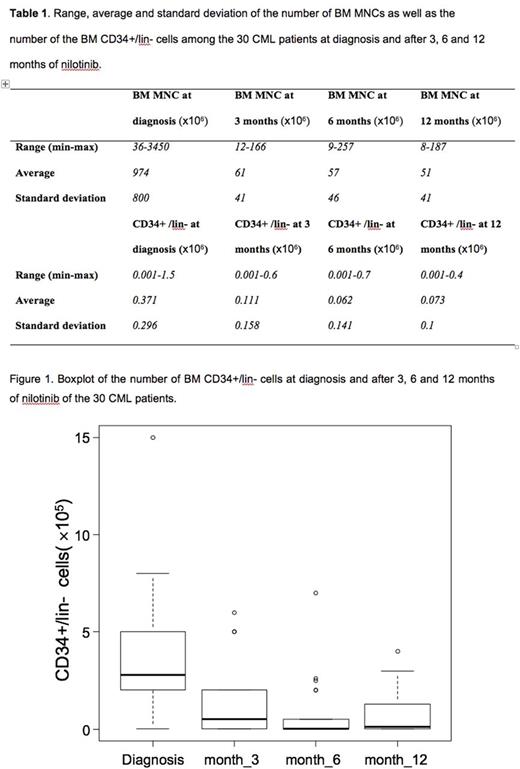Abstract
Introduction: Chronic myeloid leukemia (CML) is a clonal myeloproliferative disorder with heterogeneous biological and clinical features. The biomolecular mechanisms of CML response to tyrosine-kinase inhibitors (TKI) are not fully defined. Despite the TKI nilotinib being a very effective drug for the treatment of CML, drug resistance can emerge. In the contest of the REL-PhilosoPhi34 study (EudraCT: 2012-005062-34) on behalf of the Rete Ematologica Lombarda, we undertook gene expression profiling (GEP) of selected bone marrow (BM) CD34+/lin- cells of 30 patients with CP-CML at diagnosis vs. the same patients after 12 months of nilotinib treatment to investigate molecular signatures characterizing both conditions.
Methods: MNCs as well as CD34+/lin- cell counts of 30 CML patients were measured at diagnosis and after 3 and 6 months of nilotinib treatment, respectively.
We performed GEP of BM CD34+/lin- cells of 30 patients at diagnosis vs. the same patients after 12 months of nilotinib treatment to investigate the gene expression changes induced by nilotinib treatment using Affymetrix GeneChip HTA 2.0.
Results: The study demonstrated that the number of the BM CD34+/lin- cells dramatically decreased between the diagnosis and after 3 as well as 6 months of nilotinib treatment (Tab.1). We noticed that the BM CD34+/lin- cells slightly increased between 6 and 12 months of nilotinib treatment (Fig.1).
FISH analysis detected CD34+/lin- Ph+ cells in 30 CML patients at diagnosis. No positive Ph+ nuclei were detected on CD34+/lin- cells after 12 months of treatment.
GEP identified 264 statistically significant differentially expressed genes at diagnosis vs. 12 months of nilotinib. Functional enrichment analysis revealed groups of genes belonging to 14 pathways differentially active during nilotinib treatment.
CD34+/lin- cells after 12 months of nilotinib treatment showed altered expression of genes involved in metabolic processes: AGPAT4, LPCAT3, MBOAT2, ELOVL6, GDPD1, APOC1, ACSM3, PLD4, GLIPR1, SPNS3 (lipid metabolism), HK1, PDK3, UGGT1 (glycaemia), PRKAR2A, PRKAR2B, PTPN1, MARCKS, CAB39, RXFP1, SORT1, TBC1D4 (insulin resistance), CR1, HBB, HBBP1, HBD, HBG2, SERPINE2, KEL, F13A1 (coagulation cascade), and TLN1, FCGR2A, ITGA2B (platelet activation). Several pathways involved in cell proliferation (CSF2RB, CSF1, FLT3), RAS signaling pathway( RAB31, RASA3, RRAS2, ANGPT2), drug transporters( ABCC5), cell adhesion and cytoskeleton( CDH2, ICAM4, SELL, TEK), B cell differentiation( CD40LG, BLNK, JAK3) were up regulated whereas sphingolipid metabolism (SGMS2 and SGPP1) and apoptosis (CCNG1, GAS2, SPTA1, CDH) were down regulated in CML CD34+/lin- cells at diagnosis, respectively.
Conclusions: GEP analyses of CD34+/lin- cells of CP-CML patients at diagnosis vs. 12 months of nilotinib treatment demonstrated that several pathways were significantly differently regulated.
From our results, we can speculate that nilotinib might interfere with biologic mechanisms (lipid and glycemic metabolism, insulin resistance, coagulation cascade and platelet activation) that are relevant in CML patients treated with TKI as previously determined by several studies in literature.
The alteration of RAS signaling pathway , drug transporters, cell adhesion, cytoskeleton, B cell differentiation, sphingolipid metabolism and apoptosis in CML CD34+/lin- cells at diagnosis may underlie the increased cell proliferation that is characteristic of CML and may play a significant role in recognizing resistance mechanisms of leukemic stem cells, such as stem cell-niche interactions, cell cycle, survival, self-renewal, and metabolism.
GEP studies on a larger cohort of CML patients at diagnosis vs. 12 months of nilotinib are ongoing. We believe that BM CD34+/lin- cells from CML patients at diagnosis and after nilotinib treatment harbor differences in certain biologic and genetic properties, that may predict how well they will respond to nilotinib treatment and we will test this hypothesis.
Rossi: Gilead: Membership on an entity's Board of Directors or advisory committees; Celgene: Membership on an entity's Board of Directors or advisory committees; Sanofi: Membership on an entity's Board of Directors or advisory committees; Teva: Membership on an entity's Board of Directors or advisory committees; Amgen: Membership on an entity's Board of Directors or advisory committees; AbbVie: Membership on an entity's Board of Directors or advisory committees; Janssen: Membership on an entity's Board of Directors or advisory committees; Roche: Membership on an entity's Board of Directors or advisory committees. Orlandi: Novartis: Speakers Bureau; Bristol-Myers Squibb: Speakers Bureau; Incyte: Speakers Bureau. Iurlo: Novartis: Consultancy, Honoraria; Bristol Myers Squibb: Consultancy, Honoraria; Pfizer: Consultancy, Honoraria.
Author notes
Asterisk with author names denotes non-ASH members.


This feature is available to Subscribers Only
Sign In or Create an Account Close Modal